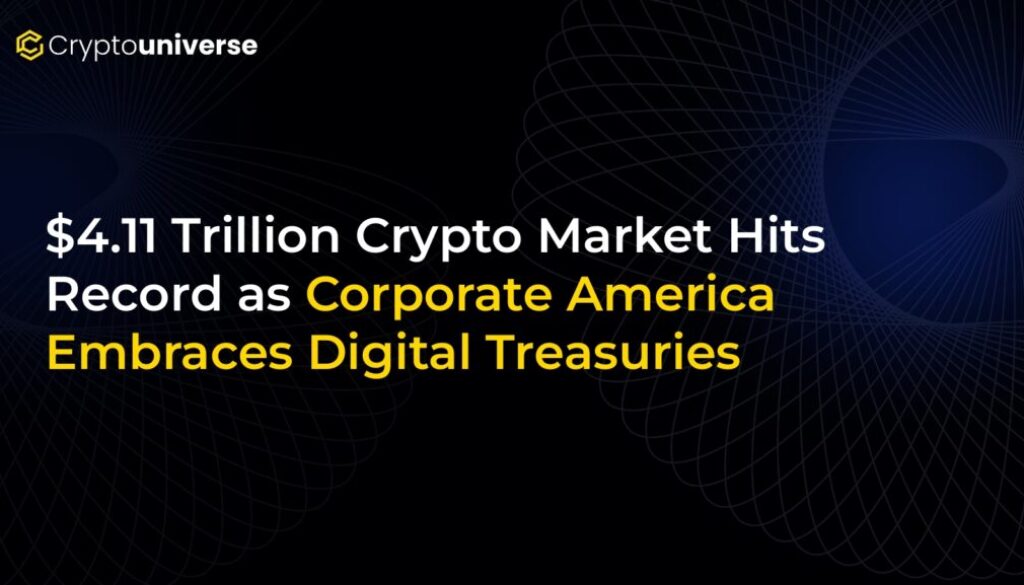$4.11 Trillion Crypto Market Hits Record as Corporate America Embraces Digital Treasuries

The Boardroom Takeover: Crypto Graduates from Speculation to Strategic Asset
The conversation around cryptocurrency is no longer confined to niche online forums and speculative traders. It’s happening in the boardrooms of Corporate America, and the numbers are staggering. As of August 2025, the total cryptocurrency market capitalization has soared to a record $4.11 trillion, a clear signal that a monumental shift is underway. This isn’t just another bull run; it’s the dawn of the digital asset treasury, where public companies are strategically integrating cryptocurrencies into their core financial operations.
With Bitcoin challenging its previous all-time highs near $124,000, the trend has become undeniable. Public companies now collectively hold over $109.49 billion in Bitcoin, while corporate Ethereum treasuries have surpassed $17.6 billion. This institutional stamp of approval, bolstered by clearer regulatory frameworks like the U.S. GENIUS Act, is transforming digital assets from a fringe investment into a cornerstone asset class.
The New Corporate Playbook: Diverse Strategies for a Digital Age
The move to adopt digital treasuries isn’t a one-size-fits-all strategy. A new wave of public companies is pioneering different models, showcasing the versatility of blockchain assets in corporate finance. These firms are moving beyond simply HODLing and are creating innovative ways to leverage the technology for growth and shareholder value.
The Proxy Play: Providing Regulated Access
A prime example of this new model is CEA Industries, Inc. (NASDAQ: BNC). The company has executed a landmark pivot, transforming itself into a dedicated digital asset treasury platform with a laser focus on BNB. After a massive $500 million private placement, BNC is on a mission to accumulate 1% of BNB’s total circulating supply.
Their strategy solves a key problem for U.S. investors: gaining regulated exposure to promising digital assets like BNB without the complexities of wallets and crypto exchanges. By holding BNC stock, investors get a proxy for BNB’s performance through a traditional, NASDAQ-listed equity. The appointment of Dr. Russell Read, a former executive at institutional giants like CalPERS, to its board underscores the seriousness and credibility of this approach.
The “Digital Standard”: Betting on an Ecosystem
While some companies offer broad access, others are making concentrated bets on specific ecosystems. Fundamental Global Inc. (NASDAQ: FGNX) is championing what it calls the “Ethereum Standard.” The company is aggressively accumulating ETH, with holdings now at 48,545 ETH (worth approximately $230 million), and has a bold ambition to become the largest corporate holder of Ethereum.
“Ethereum is the world’s most productive reserve asset, and we’re scaling to be the largest corporate holder,” said Maja Vujinovic, CEO of Digital Assets at FG Nexus.
Their strategy isn’t passive. Fundamental Global plans to leverage its holdings through staking and restaking operations, generating additional yield and actively participating in the network’s growth.
The Miner’s Evolution: From Production to Diversification
Crypto-native companies, particularly Bitcoin miners, are also evolving. Firms like Core Scientific, Inc. (NASDAQ: CORZ) and TeraWulf Inc. (NASDAQ: WULF) are no longer just pure-play miners. While continuing to mine and hold substantial Bitcoin reserves on their balance sheets, they are diversifying into high-demand sectors like High-Performance Computing (HPC).
- Core Scientific maintains a strong liquidity position of over $750 million in cash and digital assets while expanding its HPC services.
- TeraWulf increased its mining capacity significantly while building out its HPC hosting infrastructure, leveraging its expertise in low-cost, zero-carbon energy.
This hybrid model allows them to capitalize on their core crypto business while hedging against market volatility and capturing new revenue streams.
The Unconventional Pivot: Mainstreaming a Movement
Perhaps the most surprising example of the
Beyond the Balance Sheet: The Tokenization Revolution
The corporate treasury movement is just one piece of a larger puzzle. The explosive growth in tokenized real-world assets (RWAs), now a $22.5 billion market, is another critical development. Institutional giants are bringing traditional financial assets, like U.S. Treasuries, onto the blockchain. BlackRock’s BUIDL fund is a leading example, demonstrating the immense demand for on-chain, efficient, and transparent versions of traditional assets.
This convergence of corporate crypto adoption and RWA tokenization is blurring the lines between Wall Street and the digital asset world. The demand for stablecoins, often backed by U.S. Treasuries, is creating a powerful, symbiotic relationship between the two financial systems.
A Fundamental Reshaping of Finance
The rise of the digital asset treasury marks a definitive turning point for the crypto industry. What began as a speculative experiment has matured into a strategic imperative for a growing number of forward-thinking companies. From providing regulated market access and building ecosystem-specific investment vehicles to diversifying traditional business models, corporations are finding innovative ways to leverage the power of the blockchain.
As the crypto market continues to break records, one thing is clear: the integration of digital assets into corporate finance is not a fleeting trend. It is a fundamental reshaping of how companies manage capital, create value, and engage with the future of money.


